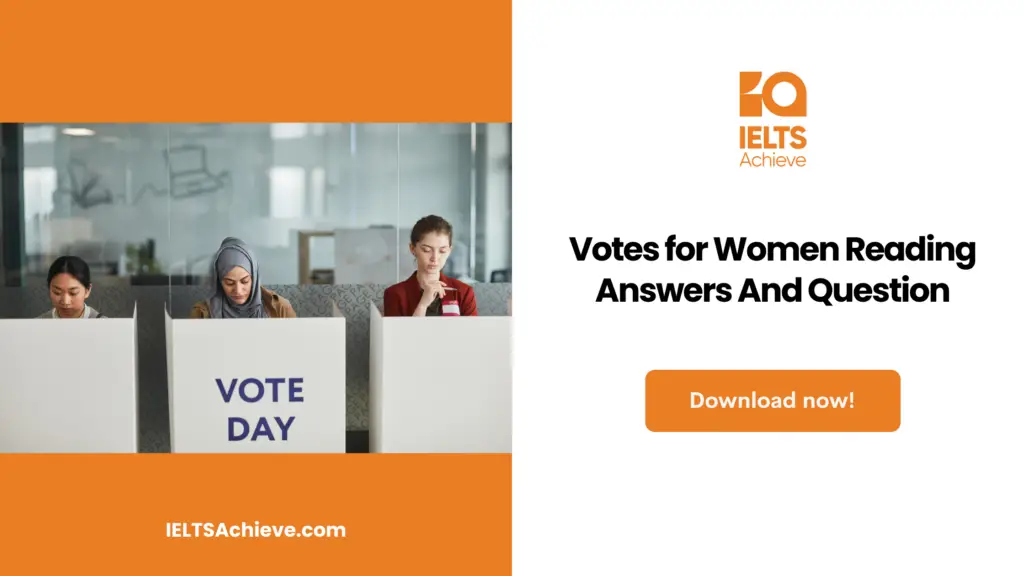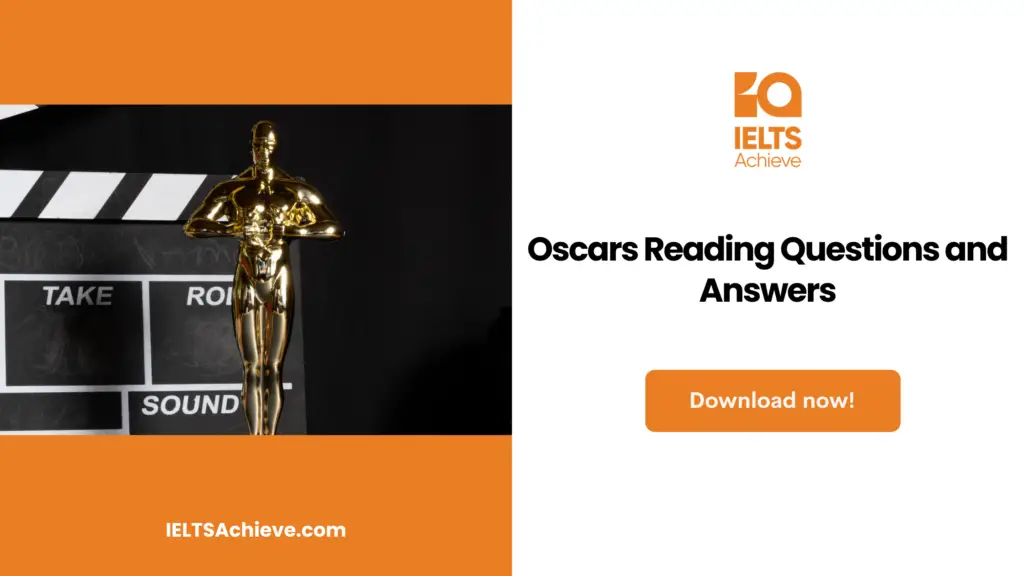The Blog post contains the following IELTS Reading Questions:
- IELTS Reading Notes Completion
- IELTS Reading Yes/No/Not given
- IELTS Reading Multiple Choice Questions
Stay informed and prepared for success – Explore our comprehensive Reading Test Info page to get valuable insights, exam format details, and expert tips for mastering the IELTS Reading section.
IELTS Reading Passage: Votes for Women

Votes for women
The Pankhurst family and various degrees of violence are most commonly associated with the suffragette movement, which fought for women’s suffrage in the early twentieth century. The Museum of London has used its extensive archive to present a new perspective. A History of the Suffrage Movement in London, 1906–1914 in Purple, White, and Green.
The name alludes to the official colour scheme adopted by the Women’s Social and Political Union (WSPU) to promote a uniform, worldwide image for the movement. The exhibition highlights the WSPU’s groundbreaking corporate identity campaign, as well as the university’s other organisational and commercial successes.
Mrs. Emmeline Pankhurst, along with her daughters Christabel and Sylvia, formed the WSPU in 1903 and began a well-informed campaign to advance women’s suffrage. While women in New Zealand, Australia, and some states in the United States were already able to vote, a growing number of Britons wanted the same right.
When the WSPU adopted the colour scheme and adopted the slogan “Deeds not words,” the movement quickly gained the unity and focus it had been lacking.
Rapid growth in membership occurred as women stopped attending meetings of competing, less focused organisations. In 1906, the Women’s Social and Political Union (WSPU) established its headquarters in Charing Cross Road under the name Women’s Press Shop. Despite the lack of radio, television, and widespread telephone use at the time, the WSPU’s message had spread across the country, with members and branch officers located as far north as Scotland.
Communication was crucial to the success of the WSPU, and the newspapers it published, first Votes for Women and then The Suffragette, were instrumental in that effort. Both were widely distributed across the country and proved to be essential in keeping people abreast of the latest developments in the movement and the locations of important meetings, marches, and fund-raisers.
Just as crucial for a burgeoning political movement was the newspaper’s financial success. Large retailers like Selfridges and jewellery stores like Mappin & Webb were regular buyers of newspaper advertising space. These two, along with other like-minded businesses sympathetic to the cause, had quickly identified a direct way to reach a massive market of women, many of whom have disposable income.
When the WSPU realised it could make money off of the scheme’s conception, they jumped on it. The organisation quickly expanded into selling a wide variety of purple, white, and green merchandize, including playing cards, board games, Christmas and greeting cards, and more. The concept of a company’s name and logo being sold as merchandise was novel in the business world back in 1906.
In addition to the paper and merchandise sales, the WSPU engaged in a slew of other fund-raising activities to bolster its “war chest” and cover operational expenses. The Woman’s Exhibition, held in a Knightsbridge ice skating rink in 1909, was the most successful of these, raising the equivalent of £250,000 in 10 days.
Exhibits at London’s Museum are primarily visual, with a vast collection on display. Copies of The Suffragette, campaign banners, and photographs line the walls, along with Mrs. shoes and various purple, white, and green mementos, against the soft hum of street sounds.
Photos capture the everyday struggles of a suffragette, from selling The Suffragette on street corners to chalking up pavements with details of an upcoming meeting to WSPU members on a self-proclaimed monster’ march in official uniforms of a white frock decorated with purple, white, and green accessories.
The high quality of the postcards and greeting cards displayed in the windows demonstrates the depth of talent within the WSPU’s ranks.
The political climate surrounding the suffragettes of the time period is laid bare for visitors in a short film assembled from vintage newsreels and cinematic footage. The show opens with a clip created by the “antis” (people who are against women having the right to vote) that portrays a suffragette as a ruthless harridan who bullies her poor, abused husband.
During a famous race, suffragette Emily Wilding Davison is seen in original newsreel footage throwing herself under King George V’s horse.
Graphic display boards outlining the bills of enfranchisement of 1918 and 1928 that gave the adult female populace of Britain the vote show what was accomplished even though the exhibition itself only covers the years 1906 to 1914. It shows how far ahead of their time the suffragettes were in terms of strategy, campaign marketing, and image construction. It shows how the suffragettes fought for equality and freedom with vigour and strength. As such, it serves as an example of the savviness displayed by women, who were once thought to have “brains too small to know how to vote” according to the opinions of several politicians.
Unlock your full potential in the IELTS Reading section – Visit our IELTS Reading Practice Question Answer page now!
Recommended Questions:
Renewable Energy IELTS Reading Question with Answer
Votes for Women Reading Questions
Questions 1-3
Complete the notes below.
Choose NO MORE THAN THREE WORDS from Reading Passage for each answer.
Write your answers in boxes 1-3 on your answer sheet.
Three ways in which the WSPU raised money:
The newspapers: primarily through sales 1.__________
Merchandising activities: selling a wide range of goods manufactured in their 2.__________
Additional fund-raising activities: for example 3.__________
Boost your performance in Summary, Notes, Table, and Flowchart Completion tasks. Click here to explore our detailed guide and learn how to effectively complete summaries, notes, tables, and flowcharts in the IELTS Reading section.
Questions 4-10
Do the following statements reflect the situation as described by the writer in Reading Passage?
In boxes 4-10 on your answer sheet write
YES if the statement reflects the situation as described by the writer
NO if the statement contradicts the writer
NOT GIVEN if it is impossible to know what the situation is from the passage
| Example | Answer |
| The WSPU was founded in 1906 by Emmeline Pankhurst | NO |
4. Women in Australia were still denied the right to vote in 1903.
5. The WSPU’s two newspapers were its primary means of communication.
6. The W SPU’s work was mostly limited to London and the south.
7. The WSPU’s newspapers were primarily concerned with social news and gossip.
8. In 1909, Parliament strongly opposed the Woman’s Exhibition.
9. Some of the goods sold by the movement are on display at the Museum of London.
10. Opponents of the suffragettes produced anti-movement films.
Want to excel in identifying the writer’s views and claims? Click here to explore our in-depth guide on how to accurately determine Yes, No, or Not Given in the IELTS Reading section.
Questions 11 -13
Choose the appropriate letters A-D and write them in boxes 11-13 on your answer sheet.
11. What is the main focus of the exhibition at the Museum of London on the work of the suffragette movement?
- The Pankhurst family’s role in the suffrage movement
- The political campaign of the movement’s violence
- the corporate image success of the movement
- the movement’s collaboration with suffrage organisations around the world
12. Why was the WSPU more successful than other suffrage organisations?
- Its leaders were far more educated.
- It received funding from international movements.
- It had access to cutting-edge technology.
- It had a clear goal and purpose.
13. In which two years were laws passed allowing British women to vote?
- 1918 and 1928
- 1906 and 1909
- 1918 and 1914
- 1928 and 1909
Ready to improve your performance in Multiple Choice Questions (MCQs)? Click here to access our comprehensive guide on how to tackle MCQs effectively in the IELTS Reading section.
Unlock your full potential in the IELTS Reading section – Visit our IELTS Reading Practice Question Answer page now!
Recommended Questions:
Renewable Energy IELTS Reading Question with Answer
Votes for women Reading answers
1. (selling) advertising (space)
2. Colour scheme
3. (the) women’s
4. No (h6)
5. Yes
6. No
7. No
8. Not given
9. Yes
10. Yes
11. C
12. D
13. A

We hope you found this post useful in helping you to study for the IELTS Test. If you have any questions please let us know in the comments below or on the Facebook page.
The best way to keep up to date with posts like this is to like us on Facebook, then follow us on Instagram and Pinterest. If you need help preparing for the IELTS Test, join the IELTS Achieve Academy and see how we can assist you to achieve your desired band score. We offer an essay correction service, mock exams and online courses.
